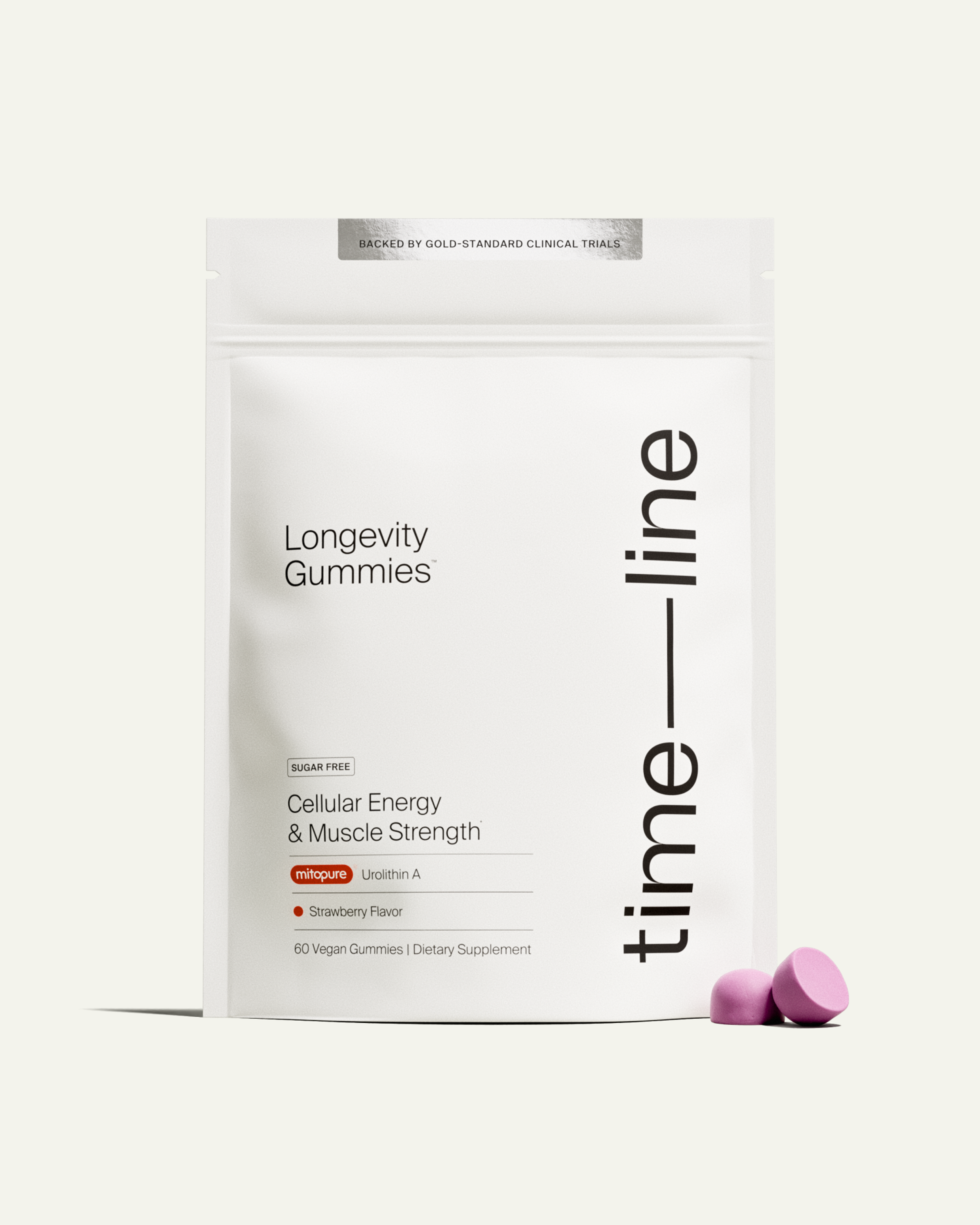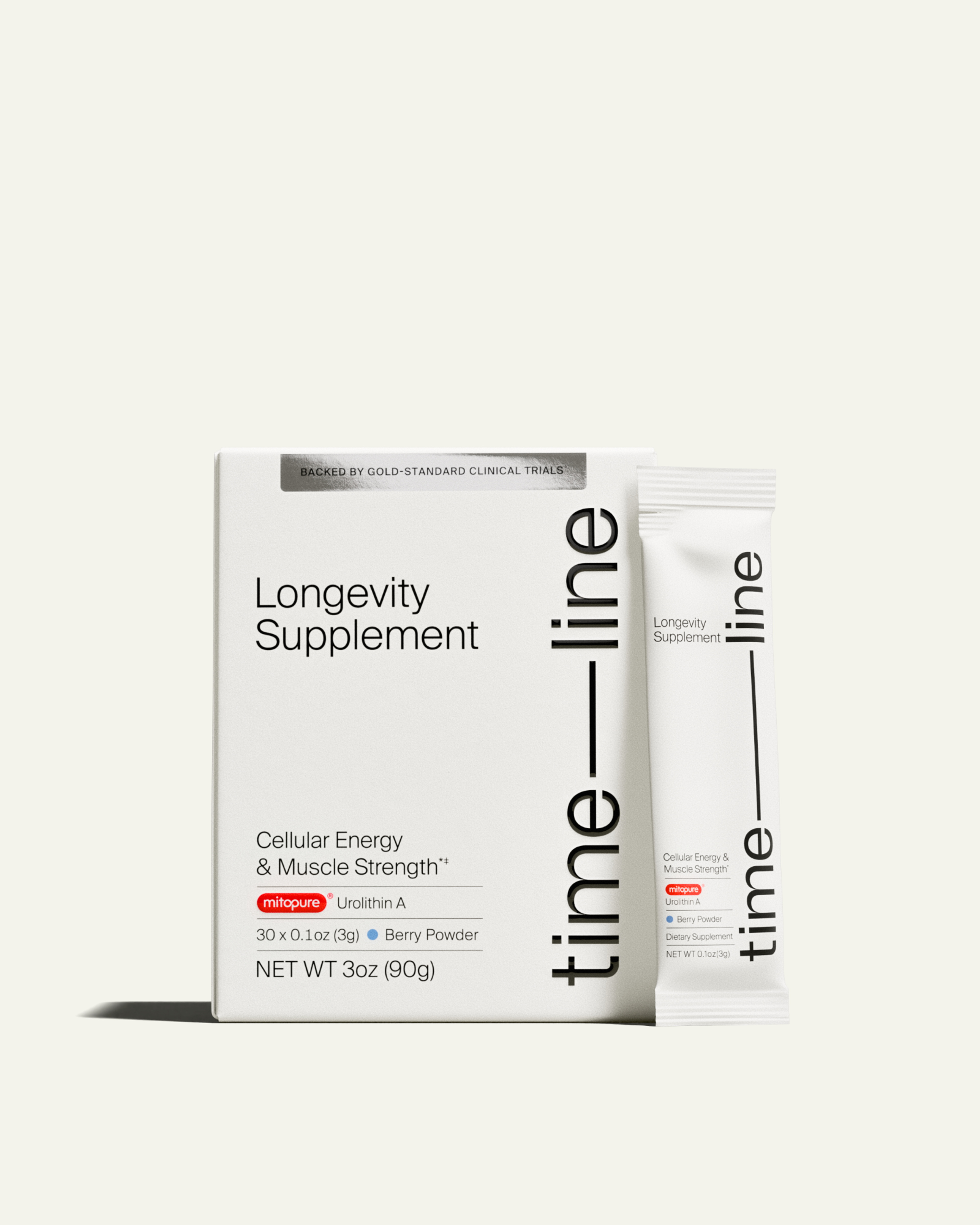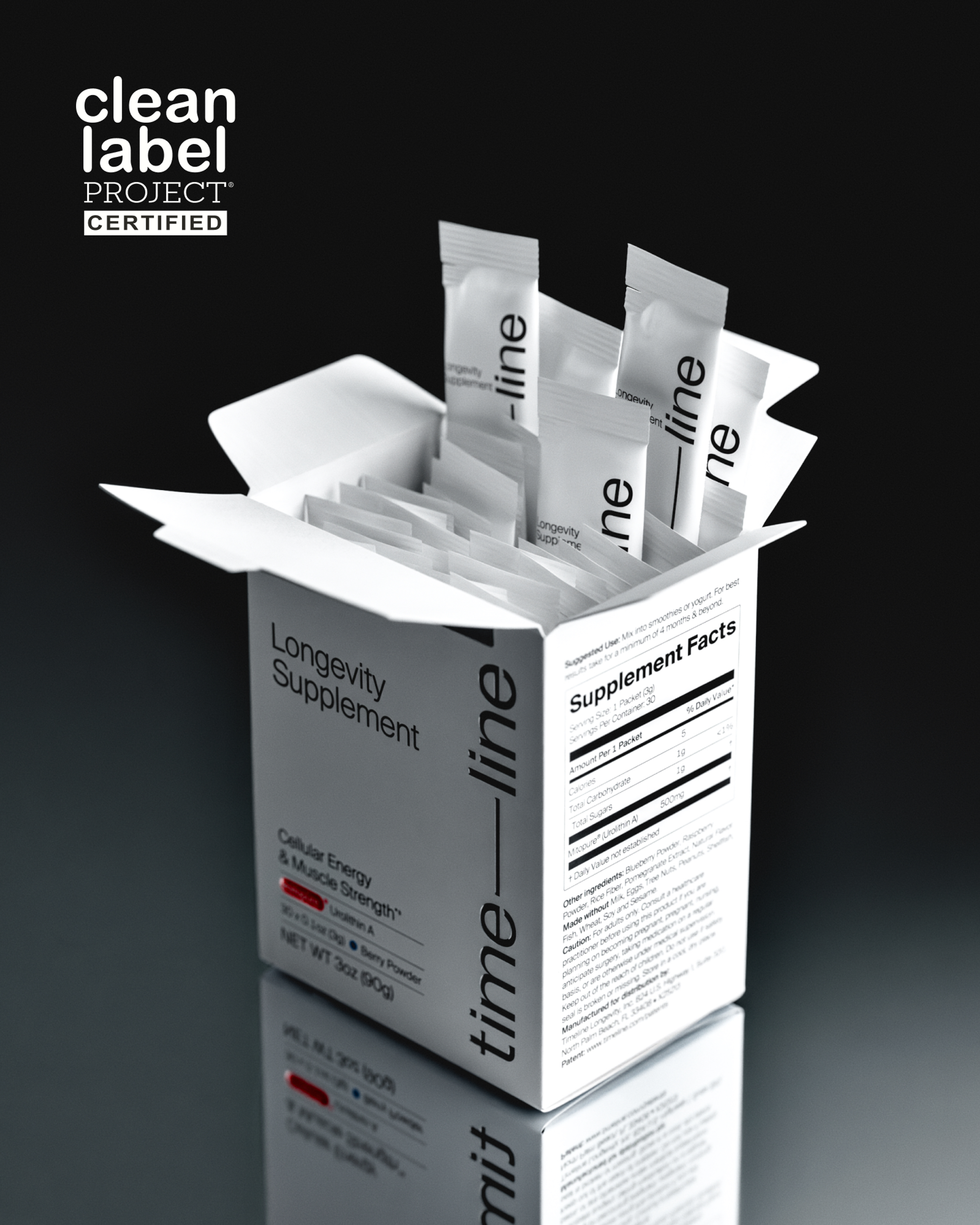Weight training: your go-to guide to getting stronger
Discover the science behind weight training - learn effective exercises, the benefits, and how to do them correctly for maximum muscle growth.
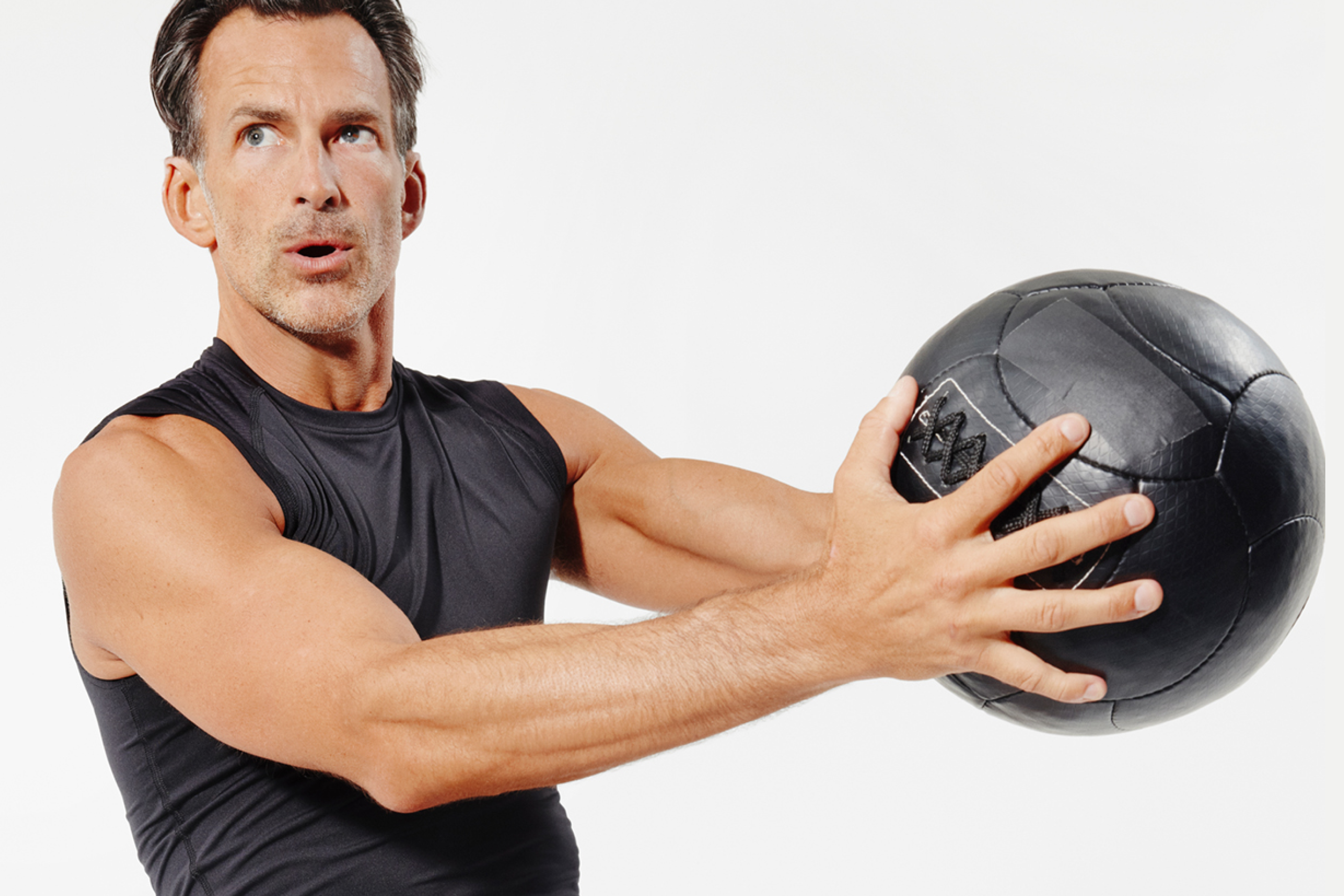
What to know
Our muscle mass starts to decrease as early as 30 years old, but certain lifestyle habits can delay this decline.
Weight training is essential to any workout regimen to keep muscles healthy and strong.
The benefits of resistance training include improved bone health, weight management, and better mental health.
Resistance training may include bodyweight exercises, free weights, weight machines, or resistance bands.
Combining resistance training with adequate protein intake, recovery days, and supplements like Mitopure® help you maximize your muscle health.
Resistance training, also called weight training, should be an essential part of everyone's fitness regimen. Its benefits extend well beyond the gym, from strengthening muscles and bones to bolstering mental resilience and self-esteem.
Many are unaware, but muscle mass starts to slowly decline as early as our 30s and then accelerates as we enter our 60s. This age-related decline, while natural, holds considerable implications. Muscular strength, a cornerstone of physical fitness, plays an independent role in warding off chronic illnesses, while muscular weakness correlates with functional limitations and physical disability.[1]
Let’s delve into the science of resistance training, its importance, and strategies to enhance endurance for optimal results.
What is Resistance Training?
Resistance training involves completing exercises aimed at improving muscle strength and endurance, with benefits extending beyond muscle health. It strengthens bones, aids in weight management, boost mood and mental health, and preserves everyday functionality as you age.[2]
The core principle involves engaging your muscles to overcome resistance and move weights across a defined distance – like lifting a dumbbell in a bicep curl. Or pushing your body weight upward in a push-up. This training encompasses body weight exercises, free weights, machines, bands, or equipment like medicine balls or kettlebells.
Depending on your preference, access to equipment, and goals, you can mix and match these types of weights and exercise to make a fitness routine tailored to your needs.
Benefits of Resistance Training
Resistance training is beneficial no matter what age you are. And it’s never too late to start training to reap the benefits.
Here are some of the top benefits of resistance training:[3]

- Improved muscle strength and tone - Regular resistance training helps enhance muscle tone, growth, and endurance.
- Strengthen bones - Resistance training positively stresses bones increasing bone density and mitigating osteoporosis risk.
- Better stability and joint health - Improves the ability to tackle everyday tasks, minimizes fall risks, and fosters popper posture and joint health.
- Weight control - Resistance training builds muscle which increases your body’s daily caloric expenditure. Pairing it with a healthy diet can further support weight loss efforts.
- Improved mental health - Research indicates that resistance exercise can alleviate symptoms of depression and anxiety[4]
- Longevity - Older adults with high muscle mass relative to their body size tend to be healthier and live longer than those with lower muscle mass.[5]
Strength Training Options
You don’t need to go to a gym or use machines to resistance train. Remember, resistance training involves using any form of resistance, whether that is dumbbells, exercise bands, or even your own body weight. After receiving medical clearance, consulting with a personal trainer is a great way to get a tailored exercise program for you. Additionally, they will be able to ensure that you are doing these exercises safely and effectively.
Bodyweight exercises
If you’re a beginner, this can be a great way to start resistance training, as no external weights are involved. Instead, you are using your own body weight to provide resistance. However, don’t mistake the absence of weights for an easy workout. Even seasoned weightlifters can find bodyweight exercises to be remarkably demanding.
A few examples are:
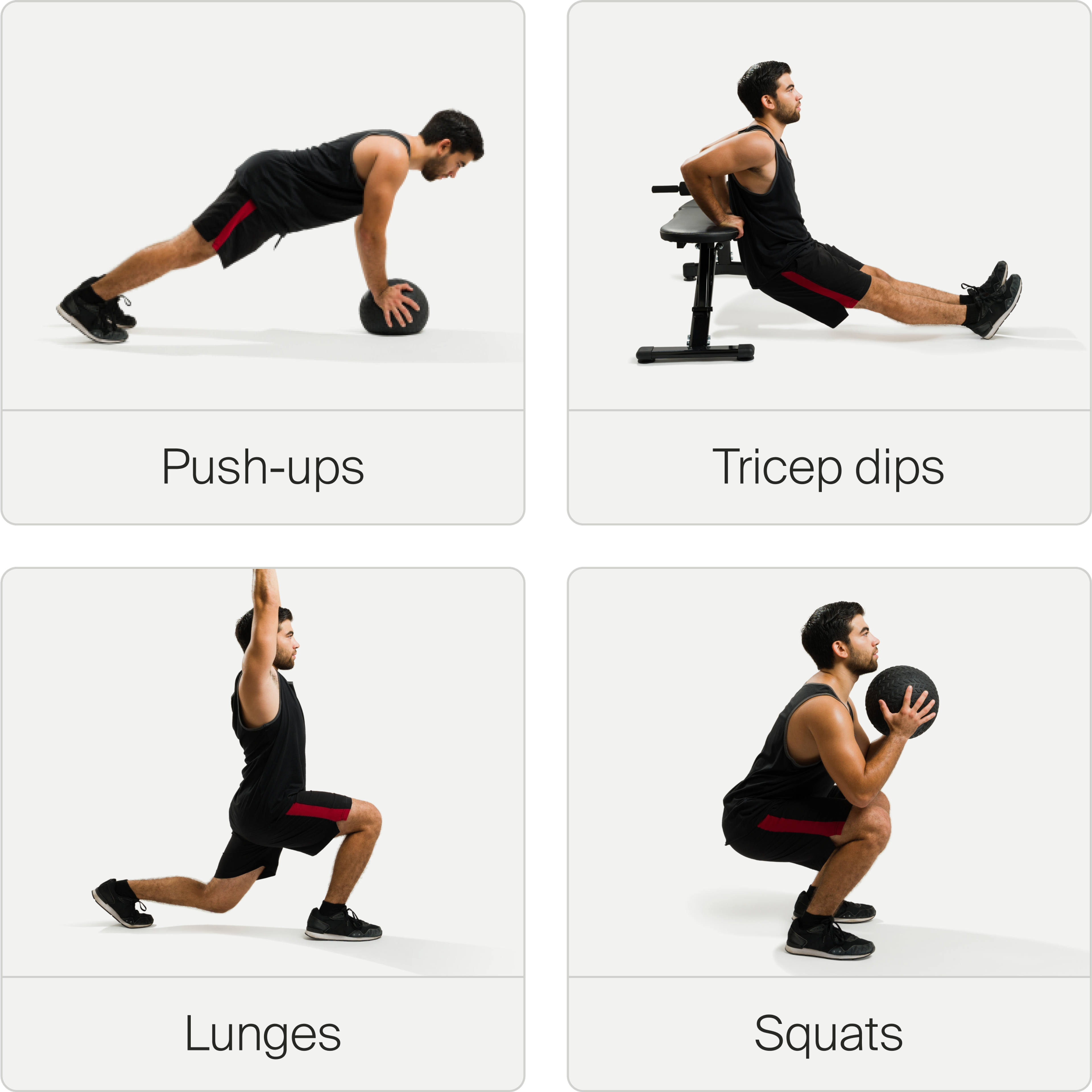
The best thing about this type of resistance training? It’s equipment-free and doable anywhere.

Weight machines
Machines typically isolate individual muscle groups like biceps or specific back muscles. You adjust the amount of weight on the machines to meet your needs, and the machine guides you through a movement to target a particular muscle. These machines tend to be expensive, so they are most often found in gyms or health clubs rather than in people's homes. If you’re new to weight training, you may not know how to use them safely. A certified personal trainer can teach you how to do these exercises properly and safely.

Free weights
Dumbbells, barbells, and kettlebells are examples of free weights. Free weights are an excellent option for building a home gym since they are inexpensive and can work almost part of the body. Free weight exercises often engage multiple muscle groups, including smaller stabilizers that machines might miss.

Resistance bands
Think of resistance bands as giant rubber bands that offer resistance when stretched. Despite being lightweight and user-friendly, they offer a challenging workout. They can be used for a variety of muscle groups and are great to travel with.
If you’re looking for something different or a bit of a challenge, you can also use medicine balls, sandbags, or other objects that can provide resistance. The main goal is to push against a heavy force; the method is your choice.
How to Optimize Your Muscle Health
To amplify your resistance training efforts and optimize your energy to perform your best, here are a few factors to consider.
Muscle strength vs muscle growth
First, recognize that targeting muscle growth and muscle strength may require different approaches. If you are trying to get stronger, focus on lifting heavier weights with fewer repetitions. In other words, high load, low reps.
While doing exercises focused on muscular strength will also build muscle, muscle building (i.e., muscular endurance and hypertrophy) requires a slightly different approach: lighter weights with more reps.
Incorporating both strategies into your resistance training plan can effectively improve muscle endurance and strength.

High protein diet
Getting enough protein and essential amino acids can help maximize your muscle-building power. Weightlifting alone is insufficient– protein intake is the other half of the equation.
Enjoy plenty of delicious protein-rich foods, including lean meats ( chicken, beef, fish) eggs, tofu, dairy, beans, and legumes.
As a general rule, you should consume 1.2-1.7 grams of protein per kilogram of body weight per day to build muscle daily. For a 150-pound person, this equals 81-116 grams a day.[7]

Example of an RM Training
RM training
Utilizing RM training or repetition maximum training can help you get stronger. Your RM is the maximum weight you can lift in a given set of resistance exercises and can be used to track your progress tracking. For example, 5-RM signifies the heaviest weight you can lift for five continuous repetitions.
Knowing your RM is helpful as a starting point so that you challenge yourself enough to see results.
You may also see RM called one-repetition maximum or 1-RM, denoting the heaviest weight you can lift in a single exercise with maximum effort. This serves as a benchmark for knowing your current capabilities and pushing yourself further. This tool is typically used by more experienced lifters and should be done with a spotter to help avoid injury.

Progressive overload
This is the process of gradually increasing the amount of stress placed on the body during your resistance training. This can be done by increasing the amount of weight lifted, the number of sets or reps, or decreasing the rest time in between sets.
Progressive overload fosters muscle turnover, the process where you are continuously breaking down and rebuilding muscle protein for greater strength. This allows you to build muscle more effectively but in a gradual and strategic way.
You may be asking yourself, “How many reps should I do to build muscle?” The number of reps and sets for muscle growth will depend on your current fitness level and goals, but a general recommendation is 8-12 reps for 2-3 sets.[8]
Supplements
Once you have sufficiently met your baseline nutrition needs through food, you may consider supplementing your diet with specific nutrients to optimize your resistance training adaptations. Here are some of the best options to consider:
- Protein powder: Many people find it challenging to meet their protein needs through whole foods alone, especially plant-based eaters. Protein powders offer a convenient way to get more high-quality protein into your diet. Choose a brand that is third-party tested, offers at least 20g of protein per serving, contains minimal added sugars, and has a taste you enjoy!
- Creatine: Creatine is one of the best-researched and most widely used supplements for muscle growth. Creatine is a type of amino acid that plays an important role in muscle metabolism by acting as an energy source for quick-burst movements like weight lifting. Although found naturally in our protein-rich animal foods like meat, fish, and dairy; supplementing with creatine can help support muscle growth and performance. The recommended intake is 5g per day of creatine monohydrate.[9]
- Mitopure®: Mitopure® is a clinically tested, highly pure form of the postbiotic Urolithin A. It works by triggering a powerful mitochondrial recycling process called mitophagy. As we age, our mitochondria become damaged, and the ability to supply critical energy to our muscle cells diminishes. Optimizing mitophagy can be a powerful way to support muscle health, and the clinical trials with Mitopure have demonstrated remarkable results*:
- A 21% increase in muscle strength after 16 weeks[10]
- A 15% increase in muscle endurance after 8 weeks[11]
- Improved cellular energy and mitochondrial health[12]

Mitopure Softgels
4.5 · 3713 reviews
The simplest form of Mitopure
Rest days
Believe it or not, incorporating rest days for strength training helps you build muscle faster. Rest days give your muscle fibers time to rebuild, emerging stronger and healthier. Taking 2-3 rest days per week is recommended for optimal muscle recovery and improved muscle strength.[13]
Bottom Line
With the combination of regular strength training, sufficient protein intake, recovery days, and supplements like Mitopure®, you can make the most of your efforts. Always remember to consult with your medical provider before starting any new fitness regimen.
Authors

Author
Dietitian-Nutritionist, and Health Content Writer
References
- ↑
Volpi E, Nazemi R, Fujita S. Muscle tissue changes with aging. Curr Opin Clin Nutr Metab Care. 2004 Jul;7(4):405-10. doi: 10.1097/01.mco.0000134362.76653.b2. PMID: 15192443; PMCID: PMC2804956.
Volaklis KA, Halle M, Meisinger C. Muscular strength as a strong predictor of mortality: A narrative review. Eur J Intern Med. 2015 Jun;26(5):303-10. doi: 10.1016/j.ejim.2015.04.013. Epub 2015 Apr 25. PMID: 25921473.
- ↑
Benefits of Physical Activity. Centers for Disease Control and Prevention. Published June 16, 2022. Accessed May 26, 2023. https://www.cdc.gov/physicalactivity/basics/pa-health/index.htm
- ↑
Strength training: Get stronger, leaner, healthier. Mayo Clinic. Accessed May 26, 2023. https://www.mayoclinic.org/healthy-lifestyle/fitness/in-depth/strength-training/art-20046670
- ↑
Strength training: Get stronger, leaner, healthier. Mayo Clinic. Accessed May 26, 2023. https://www.mayoclinic.org/healthy-lifestyle/fitness/in-depth/strength-training/art-20046670
Gordon BR, McDowell CP, Hallgren M, Meyer JD, Lyons M, Herring MP. Association of Efficacy of Resistance Exercise Training With Depressive Symptoms: Meta-analysis and Meta-regression Analysis of Randomized Clinical Trials. JAMA Psychiatry. 2018;75(6):566–576. doi:10.1001/jamapsychiatry.2018.0572
- ↑
Gordon, B.R., McDowell, C.P., Lyons, M. et al. Resistance exercise training for anxiety and worry symptoms among young adults: a randomized controlled trial. Sci Rep 10, 17548 (2020). https://doi.org/10.1038/s41598-020-74608-6
- ↑
Gordon, B.R., McDowell, C.P., Lyons, M. et al. Resistance exercise training for anxiety and worry symptoms among young adults: a randomized controlled trial. Sci Rep 10, 17548 (2020). https://doi.org/10.1038/s41598-020-74608-6
- ↑
Carbone JW, Pasiakos SM. Dietary Protein and Muscle Mass: Translating Science to 4Application and Health Benefit. Nutrients. 2019 May 22;11(5):1136. doi: 10.3390/nu11051136. PMID: 31121843; PMCID: PMC6566799.
- ↑
Schoenfeld BJ, Grgic J, Van Every DW, Plotkin DL. Loading Recommendations for Muscle Strength, Hypertrophy, and Local Endurance: A Re-Examination of the Repetition Continuum. Sports (Basel). 2021 Feb 22;9(2):32. doi:10.3390/sports9020032. PMID: 33671664; PMCID: PMC7927075.
- ↑
Wu SH, Chen KL, Hsu C, Chen HC, Chen JY, Yu SY, Shiu YJ. Creatine Supplementation for Muscle Growth: A Scoping Review of Randomized Clinical Trials from 2012 to 2021. Nutrients. 2022 Mar 16;14(6):1255. doi: 10.3390/nu14061255. PMID: 35334912; PMCID: PMC8949037
- ↑
Liu S, D'Amico D, Shankland E, Bhayana S, Garcia JM, Aebischer P, Rinsch C, Singh A, Marcinek DJ. Effect of Urolithin A Supplementation on Muscle Endurance and Mitochondrial Health in Older Adults: A Randomized Clinical Trial. JAMA Netw Open. 2022 Jan 4;5(1):e2144279. doi: 10.1001/jamanetworkopen.2021.44279. PMID: 35050355; PMCID: PMC8777576.
- ↑
Singh A, D'Amico D, Andreux PA, Fouassier AM, Blanco-Bose W, Evans M, Aebischer P, Auwerx J, Rinsch C. Urolithin A improves muscle strength, exercise performance, and biomarkers of mitochondrial health in a randomized trial in middle-aged adults. Cell Rep Med. 2022 May 17;3(5):100633. doi: 10.1016/j.xcrm.2022.100633. PMID: 35584623; PMCID: PMC9133463.
- ↑
Andreux, P.A., Blanco-Bose, W., Ryu, D. et al. The mitophagy activator urolithin A is safe and induces a molecular signature of improved mitochondrial and cellular health in humans. Nat Metab 1, 595–603 (2019). https://doi.org/10.1038/s42255-019-0073-4
- ↑
Yang Y, Bay PB, Wang YR, Huang J, Teo HWJ, Goh J. Effects of Consecutive Versus Non-consecutive Days of Resistance Training on Strength, Body Composition, and Red Blood Cells. Front Physiol. 2018 Jun 18;9:725. doi: 10.3389/fphys.2018.00725. PMID: 29967584; PMCID: PMC6015912.
Disclaimer
The information in this article is for informational purposes only and should not be taken as medical advice. Always consult with your medical doctor for personalized medical advice.
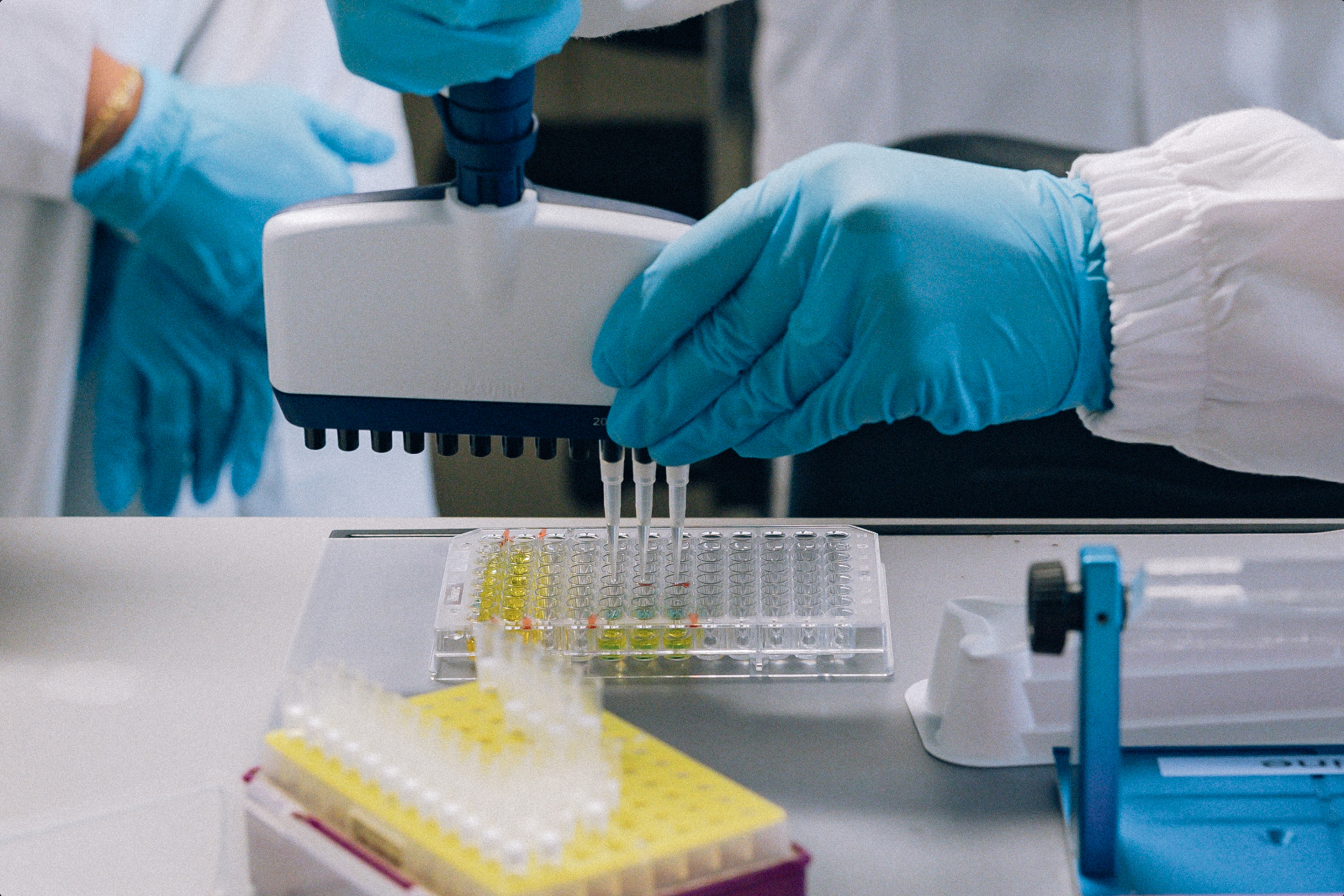
·
Nutrition·
Studies·
